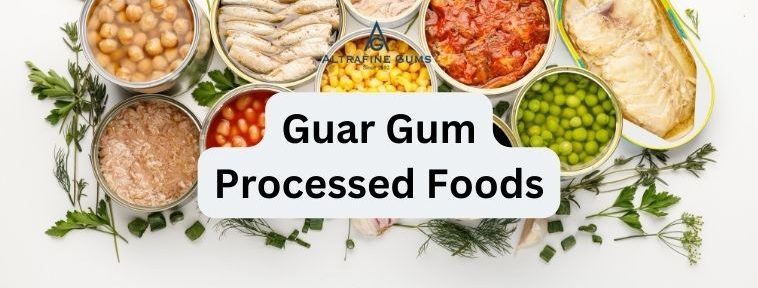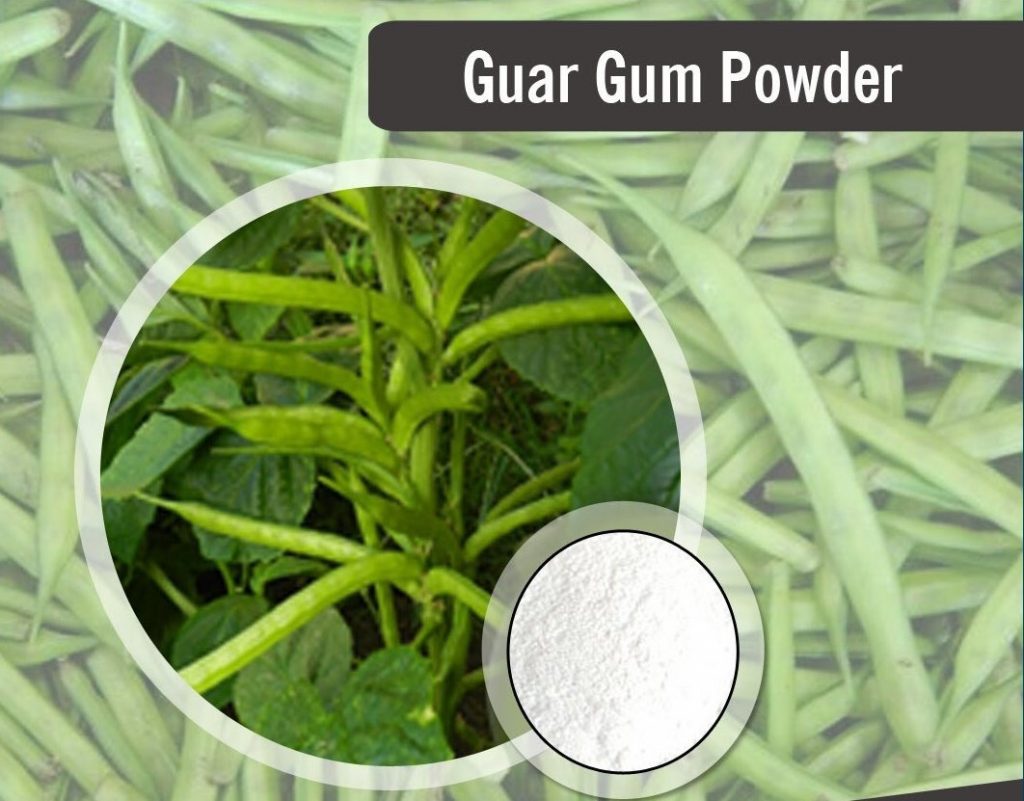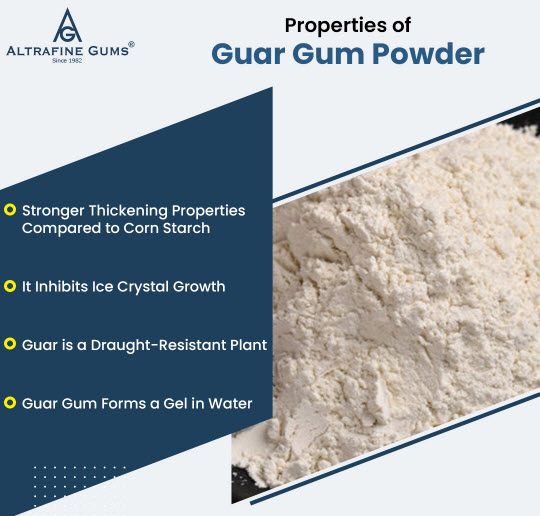
The Role of Guar Gum in Enhancing Processed Foods
Table of Contents
In the world of processed foods, maintaining the right texture, consistency, and shelf life is essential to ensuring product quality and customer satisfaction. Among the various food additives used to achieve this, Guar Gum plays a significant role. Derived from the seeds of the guar plant (Cyamopsis tetragonoloba), guar gum has been a reliable thickening agent, stabilizer, and emulsifier in the food industry. Its versatility makes it indispensable in various processed foods, helping manufacturers meet the growing demand for healthier, tastier, and longer-lasting products.
Introduction to Guar Gum in Processed Foods
Guar Gum is a natural polysaccharide, primarily composed of galactomannan, which allows it to form a gel-like substance when mixed with water. This property makes it particularly valuable in food processing, where it is used to improve the texture, consistency, and stability of various products. Guar gum is found in a wide range of processed foods, including baked goods, sauces, dairy products, and beverages.
Due to its natural origin, guar gum is widely used in products marketed as organic, vegan, or gluten-free, catering to consumers with specific dietary preferences or restrictions. Moreover, guar gum is recognized for its low-calorie content and high fiber levels, making it a popular choice in health-conscious food products.

Improving Texture and Consistency
One of the primary reasons for using guar gum in processed foods is its ability to improve texture and consistency. Guar gum acts as a thickening agent, binding water molecules and increasing the viscosity of liquid-based foods. This property is especially useful in products like soups, sauces, and dressings, where maintaining a uniform, smooth texture is essential.
In baked goods, guar gum serves as a stabilizer that prevents ingredients from separating during mixing and baking. This is particularly important in gluten-free baking, where the absence of gluten can result in dry, crumbly textures. Guar gum helps mimic the elasticity and structure that gluten provides, ensuring a soft, cohesive product.
Additionally, in dairy products like yogurt and ice cream, guar gum improves creaminess, giving a more satisfying texture without the need for high-fat content. Its ability to enhance the viscosity and thickness of these products also prevents ice crystals from forming during freezing, which can negatively affect the texture of frozen desserts.
Extending Shelf Life
In processed foods, achieving a long shelf life without compromising quality is a constant challenge for manufacturers. Guar Gum helps address this issue by acting as a natural preservative. Due to its high water-binding capacity, guar gum can reduce the activity of water in food, slowing down the growth of bacteria, mold, and yeast that cause spoilage.
Moreover, guar gum acts as a stabilizer in emulsions, preventing ingredients from separating over time. This is particularly beneficial in products like salad dressings, sauces, and mayonnaise, where oil and water need to remain blended for extended periods. By preventing separation, guar gum extends the product’s shelf life and maintains its visual and textural appeal for consumers.
In baked goods, guar gum helps retain moisture, preventing them from becoming dry and stale quickly. This moisture retention improves the freshness of the product, allowing it to be stored longer without losing its softness or flavor.

Role in Low-Fat and Sugar-Free Products
As consumers increasingly look for low-fat and sugar-free options, guar gum has become an essential ingredient in creating healthier alternatives that still deliver on taste and texture. When fat is reduced or removed from a product, its texture can suffer, often becoming thin or watery. Guar Gum acts as a fat replacer, adding thickness and creaminess without the added calories from fat.
In sugar-free products, guar gum can compensate for the loss of viscosity and bulk that sugar normally provides. Sugar plays a crucial role in giving body and thickness to food products, and without it, foods can seem too watery or thin. Guar gum helps thicken sugar-free sauces, jams, and jellies, providing the desired taste without the need for artificial thickeners or fillers.
In low-calorie beverages like smoothies and protein shakes, guar gum creates a rich, satisfying texture without the added fat or sugar. Its ability to enhance the consistency of these products ensures that consumers still enjoy a creamy drink, even when calories are reduced.
Guar Gum in Frozen Foods and Beverages
Frozen foods and beverages present unique challenges in terms of texture, as freezing can lead to the formation of ice crystals and a loss of smoothness. Guar Gum plays a crucial role in stabilizing these products by preventing ice crystals from forming, which can significantly affect the texture and overall quality of frozen items.
In products like ice cream, guar gum not only prevents ice crystals but also enhances creaminess, giving a smoother, more enjoyable texture. Its water-binding capacity helps maintain the product’s structure and consistency even after thawing, ensuring that frozen desserts do not become too watery or icy after being stored in the freezer.
Similarly, guar gum is used in frozen smoothies, frozen yogurt, and ready-to-eat meals to improve texture and stability. By preventing ingredient separation during freezing and thawing, guar gum ensures that frozen products retain their original quality, even after months of storage.
In the beverage industry, guar gum helps stabilize dairy-based drinks like milkshakes, keeping them thick and smooth even at low temperatures. This property is especially valuable for commercial beverages, where consistent texture is key to maintaining customer satisfaction.
Conclusion
Guar Gum plays an integral role in the enhancement of processed foods, offering a wide range of benefits, from improving texture and consistency to extending shelf life and supporting low-fat and sugar-free formulations. Its versatility and natural origin make it a popular choice for food manufacturers looking to create high-quality products that meet modern consumer demands.
Whether it’s thickening soups, stabilizing sauces, or improving the creaminess of ice cream, guar gum provides valuable functional properties that enhance both the texture and shelf life of processed foods. Its use in frozen products and beverages ensures that foods maintain their quality and appeal, even after extended storage.
In an industry where consumer preferences are constantly evolving, guar gum continues to be a key ingredient in delivering processed foods that are not only delicious but also healthier and more sustainable.
FAQs About Guar Gum in Processed Foods
1. What is Guar Gum, and why is it used in processed foods?
Guar gum is a natural thickening, stabilizing, and emulsifying agent derived from the guar plant. It is used in processed foods to improve texture, consistency, and shelf life. It helps bind ingredients, making food smoother and more stable, which is particularly important in products like sauces, baked goods, and dairy products.
2. How does Guar Gum extend the shelf life of processed foods?
Guar gum binds water in food, reducing the availability of moisture that promotes spoilage by bacteria, mold, and yeast. This property helps extend the shelf life of products like baked goods, sauces, and dressings by maintaining moisture levels and preventing separation of ingredients.
3. Is Guar Gum suitable for low-fat and sugar-free products?
Yes, guar gum is widely used in low-fat and sugar-free products to enhance texture and provide creaminess without the need for added fat or sugar. It helps thicken products like sauces, smoothies, and dairy products, giving them a richer texture while keeping calories low.
4. How does Guar Gum improve the texture of frozen foods and beverages?
In frozen foods and beverages, guar gum prevents ice crystals from forming, which can make products feel grainy or icy. By improving creaminess and stability, it ensures frozen items like ice cream, frozen yogurt, and smoothies maintain a smooth, enjoyable texture even after freezing and thawing.
5. Is Guar Gum safe for consumption?
Guar gum is generally considered safe for consumption and is used in many food products worldwide. However, as with any fiber-rich food additive, consuming large amounts may cause digestive discomfort such as bloating or gas. It is important to use guar gum in moderation.
6. Can Guar Gum be used in gluten-free products?
Yes, guar gum is commonly used in gluten-free products as a substitute for gluten. It helps improve the texture and elasticity of gluten-free baked goods by binding ingredients and retaining moisture, making the final product softer and more cohesive.





